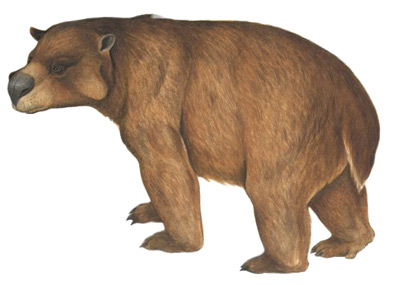
|
Search JoyZine with Google Site Search! |
Euryzygoma dunense
Euryzygoma dunense was a large (2.5m long head-tail), quadrupedal marsupial herbivore from the Pliocene of Australia. Euryzygoma is in the subfamily Diprotodontinae, distinguished from the subfamily Zygomaturinae in part by the structure of the diagnostic third premolar. In zygomaturines, this tooth is complex and multi-cusped, while in diprotodontines it is simpler in form. The snout of Euryzygoma was deep but very narrow. The cheekbones were exceptionally wide, the skull being wider than long (unusual in mammals). These cheekbones are strongly developed in some specimens but less so in others, suggesting possible differences between the sexes (sexual dimorphism). The cheeks were formed by extensions (lateral processes) of the zygomatic arch. The ends of these processes are smooth bone rather than rugose, suggesting that Euryzygoma did not have horny growths. The interior of the skull was honeycombed by numerous air spaces surrounding the comparatively tiny brain cavity. The enamel of the molar teeth was rugose, as it is in Diprotodon. Euryzygoma was a browser, feeding on leafy vegetation. Thus, when the skull of Euryzygoma was first described, it was proposed that the extensions of the cheekbones might have supported food pouches, which in some mammals may be used to store food. One possible reason for this strategy is that Euryzygoma may have therefore spent less time near dangerous, crocodile-infested waterholes. These flaring cheeks may also have been used as a sexual display: some skulls of Euryzygoma lack the flared cheekbones. Other diprotodontines (in particular, the Pleistocene Diprotodon) exhibit a high degree of sexual dimorphism (morphological differences between males and females), and it is possible that only one sex in Euryzygoma (probably male) had wide, flaring cheekbones. These strong bony extensions may have been used in male to male combat or as sexual displays. Diprotodontids first appear in the late Oligocene, about 25 million years ago. These early diprotodontids were probably descended from late Oligocene to early Miocene wynyardiids (small marsupials with a dentition intermediate between that of possums and diprotodontids) and were about the size of sheep. Like all marsupials, they began life as tiny neonates that completed their growth after birth in the mother's pouch. Living vombatiforms (koalas and wombats) have a backwardly-facing pouch, and it is probable that diprotodontoids had the same. In Queensland, Euryzygoma (E. dunense) is known from the Darling Downs in the southeast, and from Bluff Downs Station (Euryzygoma sp.) in northern Queensland. It is also known from X in northwest New South Wales.Early in the Pliocene, much of Queensland and New South Wales, like the rest of Australia, was warm temperate eucalypt forest, and rainfall was high. During the latter part of the Pliocene the climate cooled and the region became drier. Euryzygoma dunense was initially described from isolated teeth, and when first published was put into the diprotodontoid genus Nototherium (De Vis 1887). A skull of Euryzygoma was unearthed in 1912 while workers were sinking a well on the Darling Downs near Brigalow, southeastern Queensland. Several additional fossil skulls have since been found, including a beautifully preserved skull found by R. A. Stirton at Chinchilla in southeast Queensland. Numerous other bones have been found, although a composite skeleton has not been reconstructed. The subfamily Diprotodontinae is a Pliocene-Pleistocene group. In addition to Euryzygoma, the subfamily includes Bematherium, Ngapakaldia and Pitikantia from the late Oligocene; Pyramios from the late Miocene, Euowenia, Meniscolophus, Nototherium and Diprotodon from the Pliocene-Pleistocene. |
